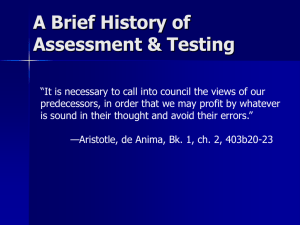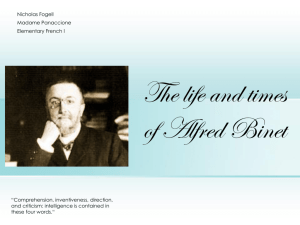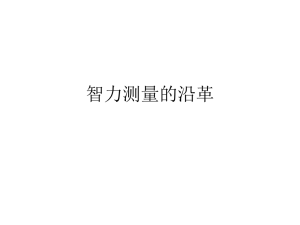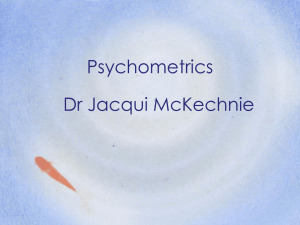None of the Above: Behind the Myth of Scholastic
advertisement
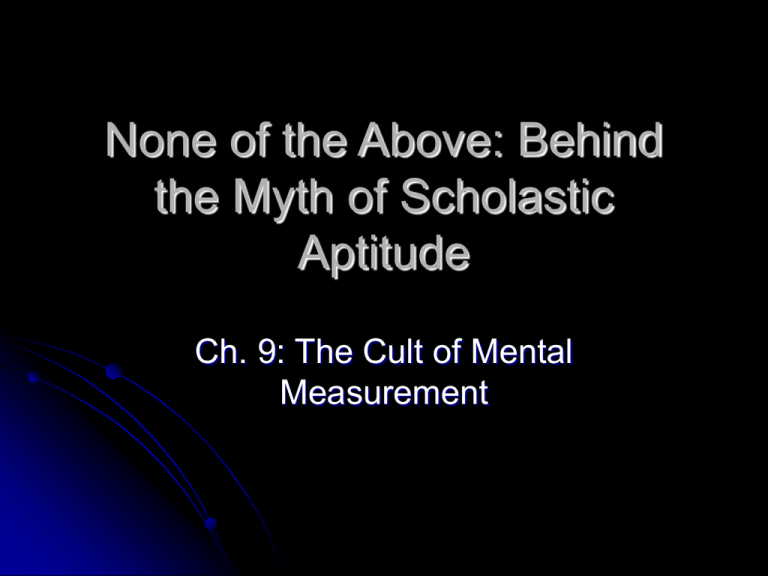
None of the Above: Behind the Myth of Scholastic Aptitude Ch. 9: The Cult of Mental Measurement Objectives Think critically about the history and rationale of the first IQ tests, and Scholastic Aptitude Test. Become familiar with the background of the individuals who developed IQ testing and the SAT. Think critically about the meritocratic rationale infused in the testing movement. Become familiar with forms of test bias. History of Intelligence Testing 1. 2. Head Circumference (Francis Galton 1880) – first attempts to measure intelligence Binet-Simon (Alfred Binet 1909) – first “intelligence test” comissioned by French gov to separate children into vocational vs academic schooling did not design test to measure ‘intelligence’ created concept of mental age (MA) The History of IQ testing First IQ tests developed by Alfred Binet Alfred Binet and Theodore Simon 30 items of increasing difficulty - 1905 Revision 1908 – age specific versions These were developed to identify children who needed ‘special’ education Binet believed that IQ could be increased by education Henry Herbert Goddard (1866-1957) Major Contributions Translated the Binet-Simon intelligence scale into English (1908) Distributed 22,000 copies of the translated Binet scale and 88,000 answer blanks across the United States (1908-1915) Established the first laboratory for the psychological study of mentally retarded persons (1910) Helped to draft the first American law mandating special education (1911) Strongly argued the hereditarian position Intelligence Testing • Alfred Binet • Introduction of Mental Age – 1916 L.M. Terman & Stanford Colleagues revise Binet’s test for use in the United States • Introduction of the term IQ – Mental Age / Chronological Age = IQ Intelligence Testing Intelligence Testing World War I - Robert Yerkes – Need for large-scale group administered ability tests by the army – Army commissions Yerkes, then head of the American Psychological Association, to develop two structured tests of human abilities Army Alpha - required reading ability Army Beta - did not require reading ability Testing “frenzy” hits between World War I and the 1930s. Robert Yerkes (1876 – 1956) Question from the Army Beta test What’s missing from each picture? Administration of the Army Alpha and Beta tests, the first “group tests,” to be followed in due course by the SAT, LSAT, GRE, etc. Carl Brigham Carl Brigham (Yerkes colleague) Explained the differences in terms of racial superiority “we notice the Einsteins of the world BECAUSE they are exceptional for their Jewish race” Brigham quite literally created the culture of standardized testing. He invented the 200-800 scale, the delta difficulty rating system, the practice of testing ne\v questions by burying them in actual tests, the equating of tests from one year to another, and the internally justified item-analysis method still used by ET'S. The theoretical foundations of the SAT Questions: What types of bias does Owen note, in The Cult of Mental Measurement? How did WWI & WWII affect the testing movement? What are some of the problems with the test questions Owen details in this chapter? What role did The Cult of Mental Measurement envision for IQ tests and the SAT? The SAT The point of the SAT was to extend the Alpha standard to what Brigham and the Board viewed as mainstream American culture. The SAT was to be the cornerstone of a new American social order - the aristocracy of aptitude, the meritocracy The SAT (U.S. Department of Commerce, Bureau of the Census, Current Population Survey) Mean verbal SAT score for children in households with incomes below $10,000: 427 Mean verbal SAT score for children in households with incomes above $100,000: 559 Intelligence There is still no clear operational definition of intelligence Both race and IQ are political rather than biological facts (Socially constructed) Heredity & Intelligence
